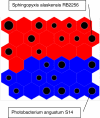The genomic basis of trophic strategy in marine bacteria
- PMID: 19805210
- PMCID: PMC2739866
- DOI: 10.1073/pnas.0903507106
The genomic basis of trophic strategy in marine bacteria
Abstract
Many marine bacteria have evolved to grow optimally at either high (copiotrophic) or low (oligotrophic) nutrient concentrations, enabling different species to colonize distinct trophic habitats in the oceans. Here, we compare the genome sequences of two bacteria, Photobacterium angustum S14 and Sphingopyxis alaskensis RB2256, that serve as useful model organisms for copiotrophic and oligotrophic modes of life and specifically relate the genomic features to trophic strategy for these organisms and define their molecular mechanisms of adaptation. We developed a model for predicting trophic lifestyle from genome sequence data and tested >400,000 proteins representing >500 million nucleotides of sequence data from 126 genome sequences with metagenome data of whole environmental samples. When applied to available oceanic metagenome data (e.g., the Global Ocean Survey data) the model demonstrated that oligotrophs, and not the more readily isolatable copiotrophs, dominate the ocean's free-living microbial populations. Using our model, it is now possible to define the types of bacteria that specific ocean niches are capable of sustaining.
Conflict of interest statement
The authors declare no conflict of interest.
Figures


Comment in
-
The trophic tapestry of the sea.Proc Natl Acad Sci U S A. 2009 Sep 15;106(37):15519-20. doi: 10.1073/pnas.0908881106. Epub 2009 Sep 9. Proc Natl Acad Sci U S A. 2009. PMID: 19805206 Free PMC article. No abstract available.
References
-
- Azam F, Malfatti F. Microbial structuring of marine ecosystems. Nat Rev Microbiol. 2007;5:782–791. - PubMed
Publication types
MeSH terms
Associated data
- Actions
- Actions
- Actions
LinkOut - more resources
Full Text Sources
Other Literature Sources
Molecular Biology Databases

